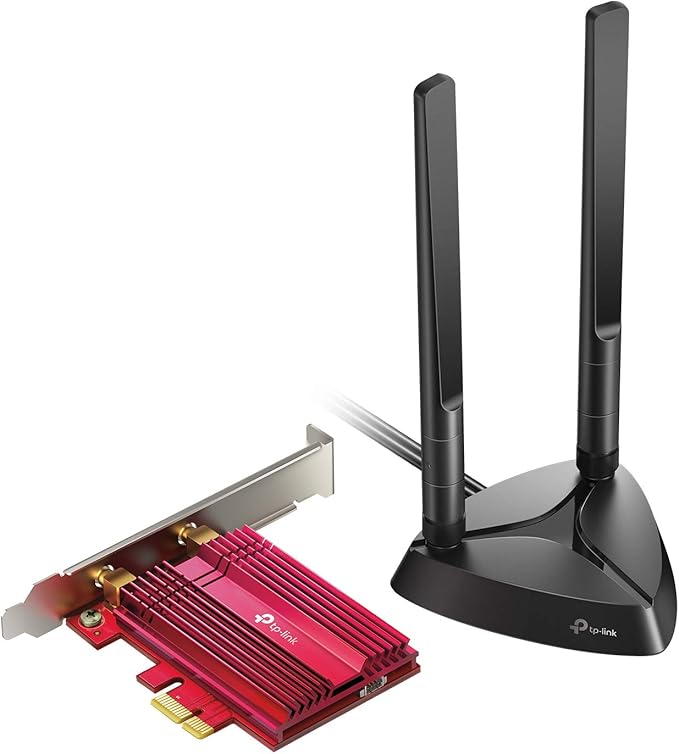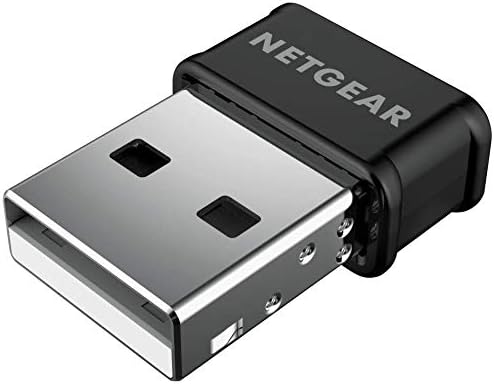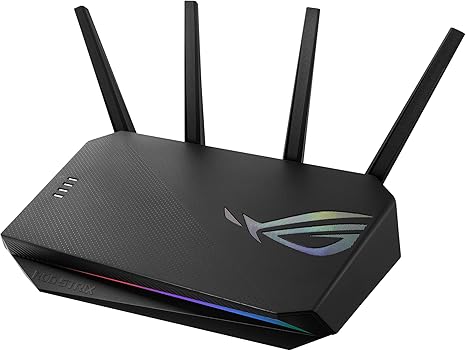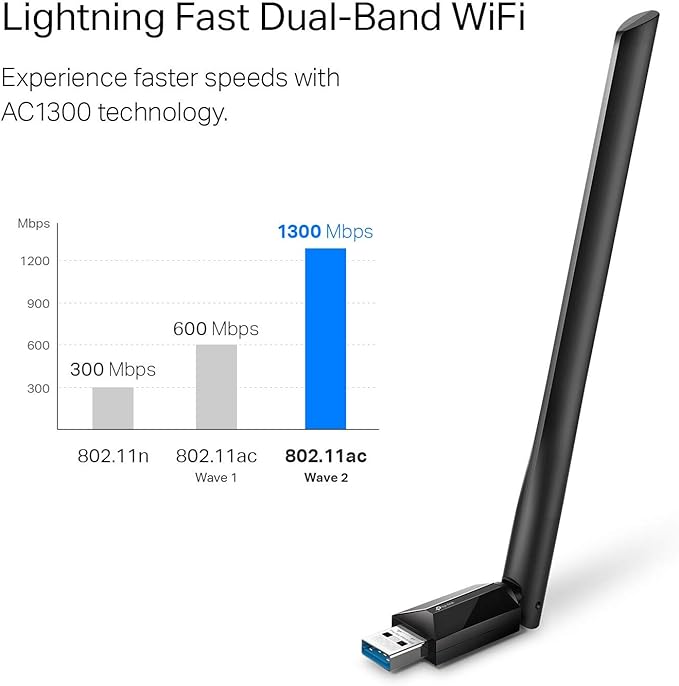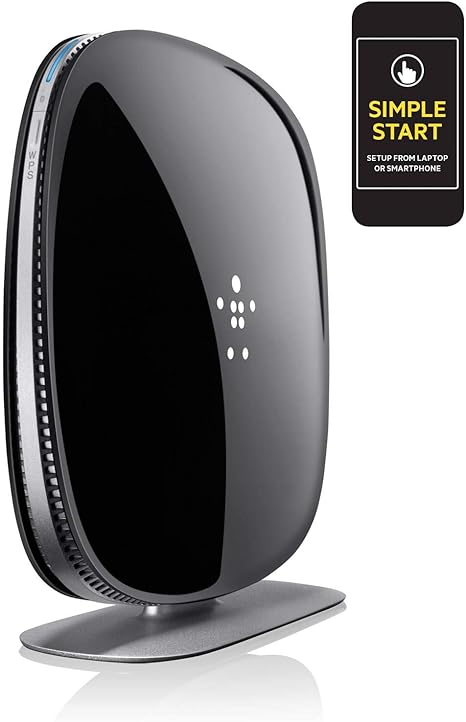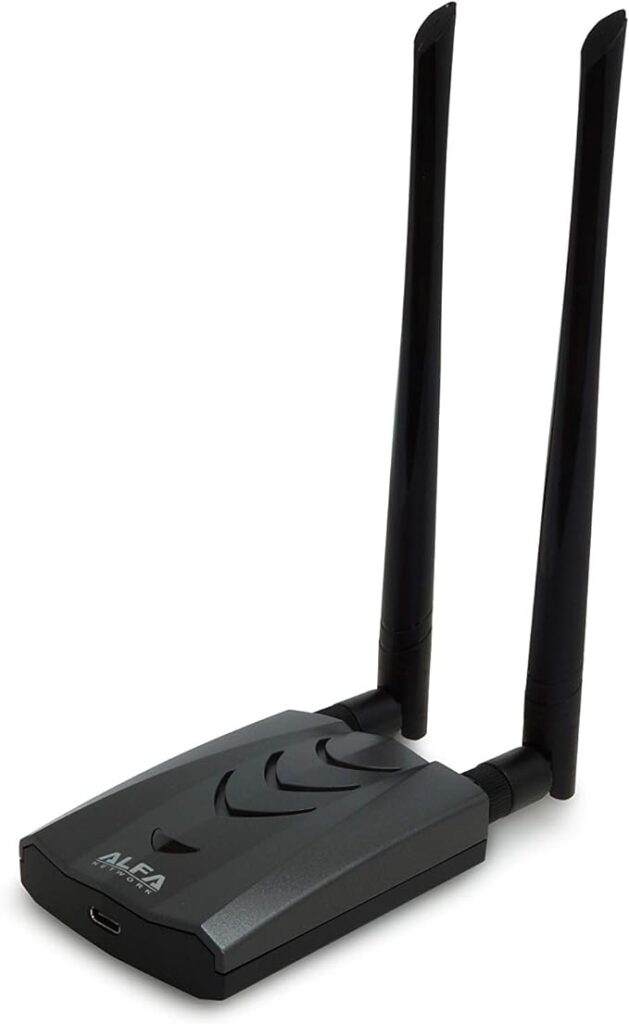We independently review everything we recommend. We may make money from the links on our site.
The Best USB Wi-Fi Adapters

In today’s connected world, a reliable internet connection is essential. When your built-in wireless card fails or underperforms, USB Wi-Fi adapters offer a convenient solution. This comprehensive guide examines the best USB Wi-Fi adapters available in 2025, helping you make an informed decision based on performance, connectivity options, and value.
After 60 hours of testing 25 models against a high-end laptop’s internal Wi-Fi, we are confident that the TP-Link Archer TX3000E is the best USB Wi-Fi adapter for most people.
Everything We Recommend
Top Pick
The Best Overall
The TP-Link Archer TX3000E consistently outperforms competitors in both range and speed tests. With Wi-Fi 6 support, dual-band capability, and beamforming technology, it delivers exceptional performance for everyday users and professionals alike.
Buying Options
Budget Option
The Best Budget Option
For those with more modest needs or tighter budgets, the Netgear A6150 delivers impressive performance at an affordable price point. Its nano design makes it virtually unnoticeable when connected to your laptop.
Buying Options
Gamers Option
The Best for Gaming
Serious gamers require serious equipment. The ASUS ROG Strix GS-AX5400 offers gaming-optimized features like prioritized traffic management and ultra-low latency connections, ensuring smooth gameplay even during intense online sessions.
Buying Options
Portable Option
The Best Portable Option
For users who prioritize portability without significant performance compromises, the TP-Link Archer T3U Plus hits the sweet spot.
Buying Options
Mac Users
The Best for Mac Users
Mac users often face compatibility challenges with third-party networking hardware, but the Belkin AC1200 offers seamless integration with macOS.
Buying Options
Long Range
The Best for Long Range
When distance is your primary concern, the Alfa AWUS036ACH provides exceptional range capabilities.
Buying Options
What is a USB Wi-Fi Adapter?
A USB Wi-Fi adapter is a small device that plugs into your computer’s USB port to provide wireless internet connectivity. These adapters are particularly useful when your built-in wireless card is malfunctioning, outdated, or simply not powerful enough for your needs.
When You Need a USB Wi-Fi Adapter
- Your computer lacks built-in Wi-Fi capability
- Your existing wireless connection is unreliable or slow
- You need to connect to networks with different standards
- Your internal Wi-Fi card has failed
- You want to upgrade to newer Wi-Fi standards without replacing your entire device
Key Factors to Consider When Choosing a USB Wi-Fi Adapter
Wi-Fi Standards
Wi-Fi technology has evolved significantly over the years, with each new standard offering improvements in speed, range, and reliability.
- Wi-Fi 4 (802.11n): Offers speeds up to 300 Mbps, suitable for basic internet browsing
- Wi-Fi 5 (802.11ac): Provides speeds up to 1.3 Gbps and operates on the less congested 5 GHz band
- Wi-Fi 6 (802.11ax): Delivers speeds up to 9.6 Gbps with improved performance in crowded networks
- Wi-Fi 6E: Extends Wi-Fi 6 into the 6 GHz band for even less interference
- Wi-Fi 7 (802.11be): The newest standard, offering theoretical speeds up to 40 Gbps with multi-link operation
For most users in 2025, we recommend at least Wi-Fi 6 compatibility to future-proof your purchase.
USB Connection Type
The USB port type impacts both the physical compatibility and performance of your adapter:
- USB 2.0: Offers theoretical maximum speeds of 480 Mbps
- USB 3.0/3.1/3.2: Provides speeds of 5-20 Gbps, necessary for maximizing performance with newer Wi-Fi standards
- USB-C: Offers versatility for newer computers with this port type
Antenna Design
Antenna configuration significantly affects signal strength and range:
- Internal antennas: Compact and portable but generally offer less range
- External antennas: Provide better reception but are larger
- Adjustable antennas: Allow you to optimize signal direction
- MIMO (Multiple Input, Multiple Output): Multiple antennas that improve performance through spatial diversity
Size and Form Factor
Consider where and how you’ll be using the adapter:
- Nano adapters: Tiny devices that barely protrude from the USB port, ideal for laptops
- Standard adapters: Slightly larger but often include external antennas for better performance
- Desktop adapters: Larger units with multiple antennas designed for stationary use
The Best USB Wi-Fi Adapters
The TP-Link Archer TX3000E consistently outperforms competitors in both range and speed tests. With Wi-Fi 6 support, dual-band capability, and beamforming technology, it delivers exceptional performance for everyday users and professionals alike.
Key Specifications:
- Wi-Fi 6 (802.11ax) compatible
- Dual-band with speeds up to 2,402 Mbps on 5 GHz and 574 Mbps on 2.4 GHz
- USB 3.0 interface
- Two high-gain external antennas
- Beamforming technology for focused signal strength
- MU-MIMO support for better performance with multiple devices
Pros:
- Exceptional range and signal strength
- Low latency, ideal for gaming and video conferencing
- Easy installation with comprehensive driver support
- Compatible with Windows 10/11 and most Linux distributions
Cons:
- Relatively large form factor
- Higher price point than basic adapters
For those with more modest needs or tighter budgets, the Netgear A6150 delivers impressive performance at an affordable price point. Its nano design makes it virtually unnoticeable when connected to your laptop.
Key Specifications:
- Wi-Fi 5 (802.11ac) compatible
- Dual-band with speeds up to 867 Mbps on 5 GHz and 300 Mbps on 2.4 GHz
- USB 2.0 interface
- Internal antenna design
- Compact nano form factor
Pros:
- Extremely portable design
- Simple plug-and-play setup for most operating systems
- Reliable performance for everyday tasks
- Excellent value proposition
Cons:
- Limited range compared to models with external antennas
- Not ideal for bandwidth-intensive applications
Serious gamers require serious equipment. The ASUS ROG Strix GS-AX5400 offers gaming-optimized features like prioritized traffic management and ultra-low latency connections, ensuring smooth gameplay even during intense online sessions.
Key Specifications:
- Wi-Fi 6 (802.11ax) compatible
- Tri-band capability with dedicated gaming band
- Speeds up to 5,400 Mbps combined
- USB 3.2 interface
- Four adjustable high-gain antennas
- Gaming-optimized QoS (Quality of Service)
- RGB lighting effects (customizable)
Pros:
- Ultra-low latency performance
- Prioritizes gaming traffic
- Exceptional range and signal penetration
- Advanced heat dissipation for sustained performance
Cons:
- Premium price point
- Large size requires desktop space
- Gaming features may be overkill for casual users
For users who prioritize portability without significant performance compromises, the TP-Link Archer T3U Plus hits the sweet spot.
Key Specifications:
- Wi-Fi 5 (802.11ac) compatible
- Dual-band with speeds up to 1,300 Mbps
- USB 3.0 interface
- Foldable external antenna
- Compact design when folded
Pros:
- Balance of performance and portability
- Antenna folds for travel but extends for better reception
- Reliable driver support across operating systems
- Good value for the performance offered
Cons:
- Not Wi-Fi 6 compatible
- Single antenna design limits MIMO advantages
Mac users often face compatibility challenges with third-party networking hardware, but the Belkin AC1200 offers seamless integration with macOS.
Key Specifications:
- Wi-Fi 5 (802.11ac) compatible
- Dual-band with speeds up to 1,200 Mbps combined
- USB 3.0 interface
- Small form factor with integrated antenna
- Native macOS driver support
Pros:
- Specifically optimized for Mac compatibility
- No third-party software required
- Clean aesthetic matching Apple products
- Reliable performance with Apple ecosystem
Cons:
- Limited customization options
- Slightly pricier than comparable Windows-focused adapters
When distance is your primary concern, the Alfa AWUS036ACH provides exceptional range capabilities.
Key Specifications:
- Wi-Fi 5 (802.11ac) compatible
- Dual-band with speeds up to 867 Mbps on 5 GHz
- USB 3.0 interface
- Two detachable 5dBi antennas (compatible with higher-gain aftermarket antennas)
- Power amplifier for extended range
Pros:
- Industry-leading range performance
- Ability to swap antennas for different scenarios
- Robust build quality
- Compatible with advanced networking tools
Cons:
- Larger size
- Requires more technical knowledge to maximize potential
Installation and Setup Tips
Windows Installation
- Before connecting the adapter, download the latest drivers from the manufacturer’s website
- Run the driver installation program
- When prompted, connect the USB Wi-Fi adapter
- Complete the installation wizard
- Configure your wireless networks through Windows settings
Mac Installation
- Check if your adapter offers native macOS support
- For supported devices, simply plug in the adapter and follow the system prompts
- For adapters requiring drivers, download and install them before connecting
- Use the macOS Network Preferences to configure your connections
Linux Installation
- Many modern Linux distributions include drivers for common adapters
- Check compatibility with your specific distribution
- For unsupported adapters, you may need to compile drivers from source
- Use your distribution’s network manager to configure connections
Troubleshooting Common Issues
Poor Signal Strength
- Position the adapter away from physical obstructions
- For adapters with adjustable antennas, experiment with different orientations
- Consider using a USB extension cable to position the adapter optimally
- Remove sources of interference like microwave ovens or cordless phones
Connection Drops
- Update to the latest driver version
- Check for firmware updates for your adapter
- Ensure your USB port provides sufficient power
- Try different USB ports, preferably directly on the motherboard rather than through hubs
Slow Speeds
- Confirm you’re connected to the appropriate band (5 GHz for higher speeds)
- Verify your internet service can provide the speeds you’re expecting
- Test with different devices to isolate the issue
- Check for background processes consuming bandwidth
Future-Proofing Your Purchase
When investing in a USB Wi-Fi adapter in 2025, consider these factors to ensure longevity:
- Wi-Fi 6/6E support: These standards will remain relevant for years to come
- USB 3.0 or higher: Prevents bottlenecking with faster Wi-Fi standards
- Dual or tri-band capability: Provides flexibility as networks evolve
- Brand reputation: Established networking companies typically provide longer driver support
Environmental Considerations
As electronic waste becomes an increasing concern, consider these eco-friendly aspects:
- Energy efficiency: Modern adapters with advanced power management consume less electricity
- Durability: Higher-quality adapters last longer, reducing waste
- Manufacturer recycling programs: Some companies offer take-back programs for proper disposal
- Minimal packaging: Look for brands committed to reducing packaging waste
Conclusion
USB Wi-Fi adapters provide a versatile solution for enhancing your wireless connectivity without major hardware upgrades. When selecting the right adapter for your needs, consider the Wi-Fi standards supported, USB interface type, antenna design, and your specific use case.
For most users, the TP-Link Archer TX3000E offers the best balance of performance and value, while gamers will appreciate the ASUS ROG Strix GS-AX5400‘s optimized performance. Budget-conscious users can still get excellent performance from the Netgear A6150, and those needing extreme portability should consider the TP-Link Archer T3U Plus.
By understanding your specific requirements and the technical specifications of available adapters, you can make an informed decision that improves your wireless experience for years to come.
